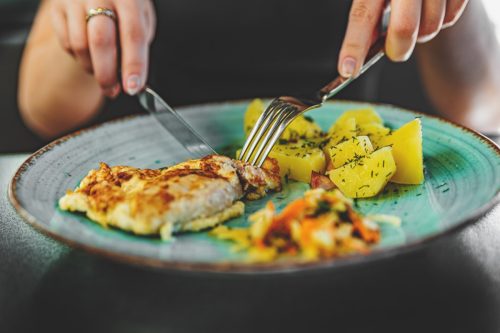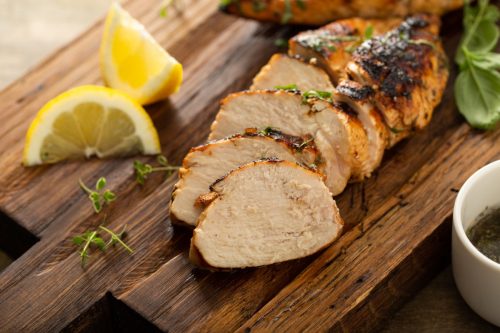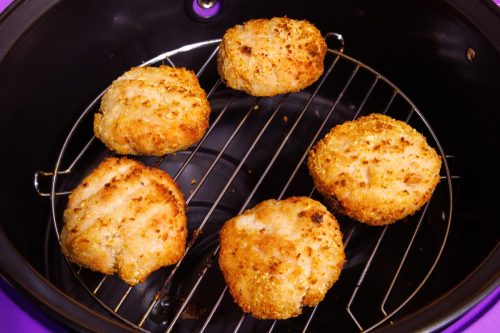The Least Safe Ways to Cook Chicken, New CDC Reports Finds

From wings to noodle soup, people in the U.S. love eating chicken. So much so, in fact, that the Centers for Disease Control and Prevention (CDC) says that we eat it more than any other kind of meat. But tasty as it is, chicken has its downsides—namely that it’s a major contributor to foodborne illnesses. A new report from the CDC has concluded that part of the problem lies in how people are preparing it. Read on to find out what the agency now says are the least safe ways to cook chicken.
READ THIS NEXT: Never Put Meat in the Fridge Without Doing This First, CDC Warns.
Chicken is a major source of food poisoning.

Salmonella is estimated to cause more foodborne illnesses than any other bacteria, according to the CDC. Chicken can sometimes be contaminated with this bacteria, making it a “major source of these illnesses,” the agency notes. In the average grocery store, about 1 in every 25 packages of chicken are contaminated with Salmonella, per a 2018 U.S. Food and Drug Administration (FDA) report.
“If you eat undercooked chicken, you can get a foodborne illness, also called food poisoning. You can also get sick if you eat other foods or beverages that are contaminated by raw chicken or its juices,” the CDC explains.
Now, a new report from the agency is delving into a concerning issue contributing to this food poisoning problem—how people are cooking certain kinds of chicken.
The CDC is now warning about specific chicken products.

The CDC released a new report about the threat of food poisoning from chicken on Dec. 2. For this report, the agency narrowed in on frozen stuffed chicken products, which “have repeatedly been implicated in Salmonella outbreaks,” the CDC said.
Since 1998, officials have linked breaded and stuffed raw chicken products to 14 different outbreaks and around 200 illnesses, according to the U.S. Department of Agriculture (USDA).
What makes breaded and stuffed chicken so problematic? According to the CDC, “these products are partially cooked to set the breading, often making them appear cooked.” Despite appearance, breaded chicken products still have to be fully cooked before they’re safe to eat, Kelly Johnson-Arbor, MD, a medical toxicology physician and director at the National Capital Poison Center, tells Best Life.
“Raw chicken, including frozen stuffed chicken products like Chicken Cordon Bleu, must be cooked to an internal temperature of at least 165 degrees Fahrenheit in order to kill foodborne bacteria such as Salmonella,” Johnson-Arbor says.
The CDC says this is the “safe internal temperature” chicken must be cooked to—and if it’s not thoroughly cooked to that temperature, you could get sick if the chicken is contaminated.
For more food safety advice delivered straight to your inbox, sign up for our daily newsletter.
The agency says some appliances shouldn’t be used to cook frozen chicken products.

Back in 2006, producers of frozen breaded and stuffed chicken products started implementing new labeling changes to “more clearly identify these products as raw,” the CDC explained in its new report. The updated labels on many also warn consumers against using microwaves to cook them, as that cooking method “historically has been reported frequently by ill persons in outbreaks associated with frozen stuffed chicken products,” per the agency.
“Use of microwave ovens does not result in uniform heating of frozen chicken products, even when chicken is covered or flipped during the cooking process,” says Johnson-Arbor. “In addition, microwave ovens that have lower wattage (600 Watts) generally do not cook frozen chicken products thoroughly enough to kill Salmonella.”
But microwaves are not the only kitchen appliance with this issue. In fact, many of the updated labels now only list cooking instructions for a conventional oven.
“While ovens can reliably achieve this temperature, microwave ovens, air fryers, and toaster ovens don’t always cook chicken thoroughly to 165 degrees, and this heightens the risk of food poisoning,” Johnson-Arbor adds.
The CDC confirmed this in its own report: “Studies indicate that microwaves, air fryers, and toaster ovens inconsistently heat frozen stuffed chicken or frozen raw breaded chicken,” the agency warned.
Many people are not following this guidance.

According to the CDC’s report, outbreaks linked to frozen breaded and stuffed chicken products have continued to occur even after labeling adjustments were made. Johnson-Arbor says this is likely because “many people do not read packaging instructions when cooking,” and the agency’s findings seem to support this.
For its new report, the CDC partnered with Porter Novelli Public Services to conduct a survey from May to July 2022, analyzing people’s preparation methods for frozen stuffed chicken products. Out of over 2,500 U.S. adults, 82.7 percent reported using an oven as one of their cooking appliances. But more than half of the respondents also admitted to using something other than their oven to cook these chicken products.
The most commonly used non-oven appliance was the air fryer, which 29.7 percent of respondents said they had cooked their chicken with. Meanwhile, 29 percent reported using a microwave, 13.7 percent used toaster ovens, and 3.8 percent cooked with another appliance.
Of course, it’s not surprising that people are turning to these appliances. “Some people, including college students, those with unstable housing situations, and mobile home residents, may not have enough space in their residence to accommodate a traditional oven, or may not have the financial reserves to purchase an oven,” Johnson-Arbor explains. “Toaster ovens, microwaves, and air fryers are typically much less expensive than traditional ovens, and also take up much less space, making them desirable for many people.”
If you are going to use something like a microwave or air fryer to cook frozen chicken, whether it’s breaded or not, a food thermometer can lower your risk of foodborne illness, according to Johnson-Arbor. The toxicologist says this tool can help you ensure that your chicken is cooked to an internal temperature of at least 165 degrees Fahrenheit.
“But when in doubt, or if a food thermometer is not available, do not eat raw chicken that has been cooked in an air fryer, microwave, or toaster oven,” she concludes.